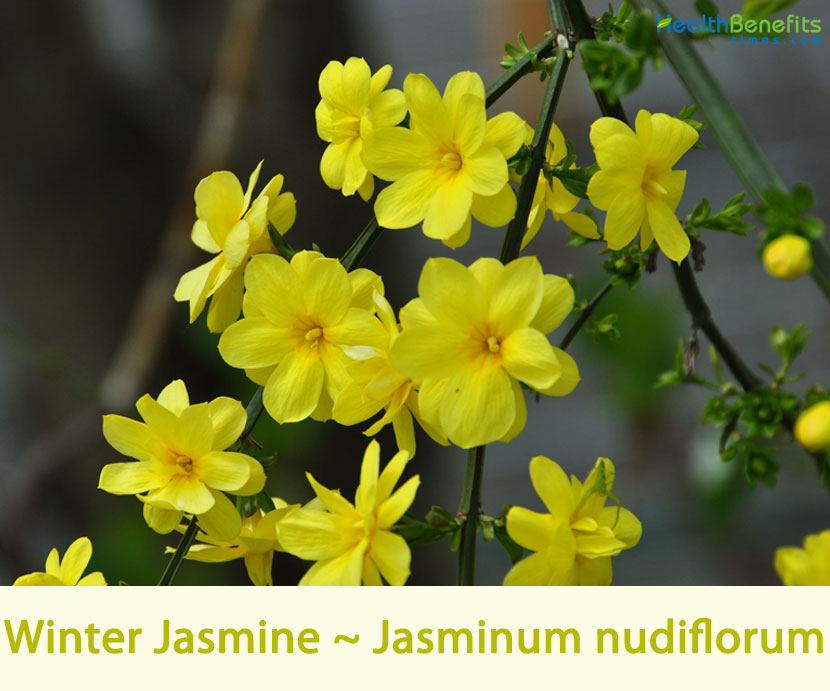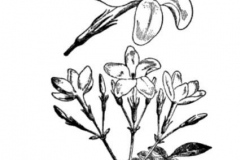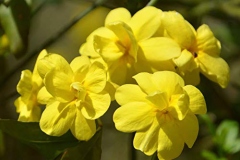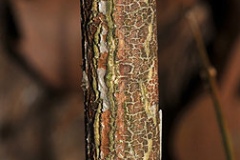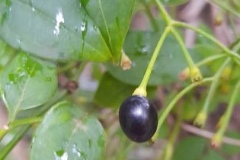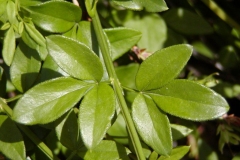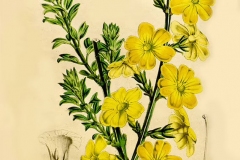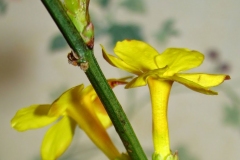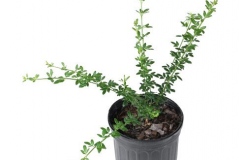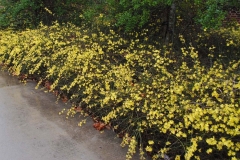| Winter Jasmine Quick Facts | |
|---|---|
| Name: | Winter Jasmine |
| Scientific Name: | Jasminum nudiflorum |
| Origin | China. It is reportedly naturalized in France and in scattered locations in the United States (Texas, Oklahoma, Georgia, Tennessee, Maryland and New Jersey). |
| Colors | Green when young turning to black as they mature |
| Shapes | Small two-lobed black berry |
| Health benefits | Dermatosis, coryza, Nasal Hemorrhage, infections, wounds, toothaches, stomatitis, headaches, kidney stone and burn treatment |
| Name | Winter Jasmine |
|---|---|
| Scientific Name | Jasminum nudiflorum |
| Native | China. It is found within many Provinces of China, (including Guangxi (Gansu), Shanxi, Sichuan, Xizang (also referred to as Tibet) and Yunnan |
| Common Names | Winter-Flowering Jasmin, Winter jasmine |
| Name in Other Languages | Albanian: Jasemin Azerbaijani: Çılpаqçiçək jаsmin Bulgarian: Ran khrishchel (ран хрищел) Catalan: Englantina Chinese: Ying chun hua (迎春花) Croatian: Pravi jasmin Czech: Jasmín nahokvětý Danish: Vinter-Jasmin Dutch: Winterjasmijn English: Winter Jasmine, winter-flowering jasmine Finnish: Talvijasmiini French: Jasmin d’hiver, Jasmin à fleurs nues German: Winter-Jasmin Hungarian: Téli jázmin Italian: Gelsomino a giori nudi, Gelsomino d’inverno, gelsomino a fiori nudi Japanese: Obai (オウバイ) Korean: Yeong chun hwa (영춘화) Malayalam: Jāsmīnaṁ nuḍiphlēāṟaṁ (ജാസ്മീനം നുഡിഫ്ലോറം) Norwegian: Vintersjasmin Persian: یاسمن زمستانه Polish: Jaśmin nagokwiatowy, jaśminek nagokwiatowy Portuguese: Jasmim-amarelo, Jasminum-amarelo, jasmim-de-são-josé, jasmineiro-do-inverno Russian: Zhasmin golotsvetkovyy (жасмин голоцветковый), zhasmin golotsvetnyy (жасмин голоцветный) Spanish: Jazmin, jazmin de San José, jazmín Amarillo, jazmín de invierno Swedish: Vinterjasmin Ukrainian: Zhasmin holotsvityy (жасмін голоцвітий) Welsh: Jasmin y Gaeaf |
| Plant Growth Habit | Slender, deciduous, broad-growing, relatively flat-growing perennial shrub |
| Growing Climates | Thickets, ravines and slopes |
| Soil | Grows well in heavy clay soils. Prefers a good soil and a sunny position but succeeds in shade, including on a north facing wall. Tolerates very poor soils, whether acid or alkaline. Tolerates urban pollution |
| Plant Size | 4 feet (1.2 m) in height with a width of 7 feet when unsupported. When it grows on a trellis, this vine can reach sizes of up to 15 feet (4.6 m) |
| Root | Shallow roots |
| Stem | Stems are square, 2mm wide, green and can be fairly effective in the winter landscape; the green stands out in contrast to the grays and browns |
| Bark | Barks are green during the first year, turning gray to red brown, thin and finely scaly and have a smooth surface |
| Twigs | The young twigs are dark green in color, becoming brown with age. The twigs are glabrous and square in cross section. Stem tips easily root when in contact with the soil |
| Leaf | Opposite, composed of three leaflets borne on a common stalk about 1⁄4 in. long. Leaflets are oval-oblong, 1⁄2 to 1 in. long, one-third to half as wide, tapered at both ends, deep lustrous green, not toothed, but furnished at the margin when young with tiny hairs |
| Flowering season | November to February |
| Flower | Solitary, bright yellow in color, and salver form in shape with five to six wavy petals. They are 3⁄4 to 1 in. diameter |
| Fruit Shape & Size | Small two-lobed black berry |
| Fruit Color | Green when young turning to black as they mature |
| Propagation | By semi-ripe cuttings, Layering |
Plant Description
Winter jasmine is a slender, deciduous, broad-growing, relatively flat-growing perennial shrub that normally grows about 4 feet (1.2 m) in height with a width of 7 feet when unsupported. It will take five to ten years to reach these heights. When it grows on a trellis, this vine can reach sizes of up to 15 feet (4.6 m). The plant normally grows in thickets, ravines and slopes, at altitudes between 800 and 4500 m above sea level. The plant grows well in heavy clay soils. It prefers a good soil and a sunny position but succeeds in shade, including on a north facing wall. It tolerates very poor soils, whether acid or alkaline. It tolerates urban pollution. These are plants that climb up other plants, trellises, walls or even rocks with the help of long, sparse shoots, but do not form roots.
Stem
Stems are square, 2mm wide, green and can be fairly effective in the winter landscape; the green stands out in contrast to the grays and browns. The young twigs are dark green in color, becoming brown with age. The twigs are glabrous and square in cross section. Stem tips easily root when in contact with the soil. Barks are green during the first year, turning gray to red brown, thin and finely scaly and have a smooth surface.
Leaves
Leaves are opposite, composed of three leaflets borne on a common stalk about 1⁄4 in. long. Leaflets are oval-oblong, 1⁄2 to 1 in. long, one-third to half as wide, tapered at both ends, deep lustrous green, not toothed, but furnished at the margin when young with tiny hairs. They have entire margins and palmate venation. They turn an attractive yellow in autumn. The leaves have a tomentose surface.
Flowers & Fruits
Flowers are solitary, bright yellow in color, and salver form in shape with five to six wavy petals. They are 3⁄4 to 1 in. diameter, produced from November to February. They are produced on stalks 1⁄4 in. long, clothed with several small, narrow green bracts. Corolla is tubular at the base and nearly 1 in. long, spreading into six divisions. Calyx-lobes are linear and pointed. The flowers are not fragrant. The plants flower on last year’s shoots. They are hermaphroditic; pollination takes place by allogamy through animals. Fertile flowers are followed by small two-lobed black berry.
Traditional uses and benefits of Winter Jasmine
- In northern India, the bark of winter jasmine has been used as a burn treatment.
- People use it to treat dermatosis, coryza, and Nasal Hemorrhage.
- They also can treat infections, wounds, toothaches, and stomatitis.
- People use their roots to remove dark shades, headaches, and kidney stone release.
Other Facts
- It is a good soil stabilizer for steep banks, succeeding in shady positions.
- The sprawling branches make this a good plant for ground cover, the plants should be spaced about 1.8 meters apart each way.
- Winter jasmine is said to be a symbol of elegance and grace, It is also the flower of Epiphany, and is dedicated to the Virgin Mary in the Christian calendar.
- It is used to make perfumes, cosmetics, and medicines.
- Women also wear it on their heads.
References:
https://npgsweb.ars-grin.gov/gringlobal/taxon/taxonomydetail?id=20666
https://pfaf.org/user/Plant.aspx?LatinName=Jasminum+nudiflorum
https://www.missouribotanicalgarden.org/PlantFinder/PlantFinderDetails.aspx?kempercode=a152
https://www.cabi.org/isc/datasheet/28385
https://en.hortipedia.com/Jasminum_nudiflorum
http://floraofalabama.org/Plant.aspx?id=5342
https://landscapeplants.oregonstate.edu/plants/jasminum-nudiflorum
http://dendro.cnre.vt.edu/dendrology/syllabus/factsheet.cfm?ID=958
http://www.theplantlist.org/tpl1.1/record/kew-351463
https://en.wikipedia.org/wiki/Jasminum_nudiflorum
https://gd.eppo.int/taxon/IASNU
https://www.itis.gov/servlet/SingleRpt/SingleRpt?search_topic=TSN&search_value=503237#null
https://plants.usda.gov/home/plantProfile?symbol=JANU


